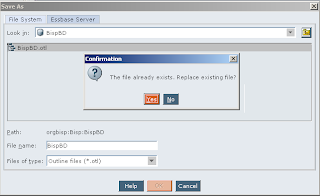Essbase Beginner’s Guide Chapter-IX
How to Create New Essbase Application?
Step1:-Right click on applications :- Create application :- Using block storage

Step2:- Give application name

Step3:-Right click on new application and create a new database as “BispDB”

How to create outline?
Outline :- Outline is structure of multidimensional database. How many dimensions are there? Outline contains hierarchal structure; there members, attributes and other dimension properties.
Step 1:- Open outline “*.otl” file.

Browse for “*.otl” file source. Select required file then click ok.

Outline is opened

Step2:- Save opened outline into newly created database file. The absolute path of outline file shown in below image.

Empty outline is already exist replace that one with structured out line file.

Outline is saved success fully.


How to create attributes dimension and associate with base dimension?
Answer: - There is one button through which you can add new sibling to the selected member.

Here customer is added as new sibling.

Add child in to customer as kids, mans and women. Same way outline can be customizing as per requirement.

Right click on any child a popup window comes up with all possible operations.

Select edit member properties options; there are some tabs where the all information about that member is available. Information tab shows member information type of member, alias properties and other.

Two attributes can associate through associations tab.

Once all properties set verify changes then save changed outline.

Skip Properties

Skip none: - Does not skip data when calculating the parent value.
Skip Missing: - skips #missing data when calculating the parent value.
Skip Zeros: - skip data that equals zero when calculating the parent value.
Skip Missing and zeros: - Skips both #missing data and data that equals zero when calculating the parent value.
Block Storage Option (BSO)
Creating Applications and Databases
Create an application using block storage. Aggregate Storage used for big storage and Block Storage is for respectively small storage. You create an application on the server. Each application can contain one or more databases.
When creating a database, keep the following design considerations in mind:
Ø A database within an application may have the same or a different name as the application to which it belongs.
Ø A database has only one outline associated with it. (The outline has the same name as the database and is a pictorial view of your database structure.)
Ø Typically, a database has other objects associated with it, including calculation scripts, reports scripts and load rules.
Ø The conventional advice is to create only one database per application:
Ø If you have trouble with one database, other databases are not affected because they are in a different application.
Ø The application log (which writes information about the databases it contains) is easier to read.
Select respective server there can be more than one server in Essbase. Essbase have the facility to manage server or administration of server from remote place. Select server give application name as in this example “PBC” is an application.

New sales application is created this time application is empty.

For creating database right click on application. Go to create database and give name to database.

Select database type as normal click ok.

New “SalesORG” database come up with some respective container as outline.

This is the folder structure with respect to “PBC” application and “SalesORG” database.

Folder structure of database files
SalesORG.db = Database File
SalesORG.dbb = Database Backup File
SalesORG.esm = Essbase File
SalesORG.otl = Outline File
SalesORG.tct = Transaction Control File
Creating Dimensions and Members
An outline contains multiple dimensions reflecting such database elements as time frame, scenarios, accounts, and products. The first member under the database member defines a dimension. You may have as many dimensions as you want; however, as a rule:
Ø Most Essbase databases have six to eight dimensions.
Ø Four or five dimensions are on the low side.
Ø Ten or eleven dimensions are on the high side.
Databases with few dimensions generally calculate quickly.
Databases with many dimensions incorporating many members and complex hierarchies generally take a long time to calculate and have large storage requirements.

Dimension Hierarchies
Each dimension contains a hierarchy of members. The hierarchy reflects many different elements within the database:
Ø Member names (or labels) that define possible data intersections
Ø Consolidation path or rollup of lower to higher level members
Ø Drill-through path that users follow when navigating through the data

Dimensions may have a few members or many members. It is not uncommon for hierarchies to contain thousands of members with as many as twelve levels in the principal rollup path.

No comments:
Post a Comment